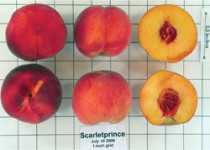Stone Fruit: Whose (Intellectual) Property Is It Anyway?

|
|
|
|
I remember as a young boy in the early 1970s being with my parents and my grandmother when visiting a local commercial greenhouse. My grandmother lived in the Caribbean and was an avid gardener who skillfully grew all kinds of plants. This particular day I noted her picking off a leaf of one plant, wrapping it in a Kleenex, and putting it in her purse. I thought it was a bit odd to do this and asked what she was doing. She told me that she was getting a leaf so that she could grow a new plant when she got home. I was intrigued to know you could do that!
As a horticulture student at the University of Guelph in the early 1980s, my all-time favorite course was plant propagation. We propagated just about everything imaginable and got to bring our successful propagules back to our dorm room, and home in the summer. I had African violets, Dieffenbachia (dumb cane), a rubber tree, etc. While working during the summer in the nursery of the Western Ontario Fruit Testing Association, I collected and prepared budwood for sale and also budded peaches, nectarines, and apricots. It was fun to see plants get multiplied for the commercial fruit industry and to watch as new orchards were established.
Vegetative (or asexual) plant propagation has been practiced for millennia. In fact, there is evidence that the Chinese were grafting plants as early as 1560 B.C. In Romans 11:17-24 of the Holy Bible, the Apostle Paul speaks figuratively of Gentiles as wild olive shoots being grafted into the root of the olive tree because of their faith. For centuries, people have freely shared their favorite fruit cultivars with one another. However, what was once a simple and acceptable thing to do has become very complicated and it may actually be illegal.
Patent Principles
Most peach and nectarine cultivars that are currently in the trade arose from either a public or a private breeding program. Many public programs [taxpayer funded (i.e., USDA-ARS)] will issue a formal release document announcing a new cultivar and it will be freely available through the commercial nursery trade at some point in the future (i.e., Scarletprince). Such trees will not have a royalty fee assessed for them. However, as some public funded programs are now patenting new cultivars, a royalty fee would be assessed for those.
The first plant patent for a fruit crop was the thornless young dewberry (USPP#4, issued Oct. 20, 1931). Luther Burbank’s widow acquired several patents for plums and other plants developed during his lifetime. Many private peach and nectarine breeding companies (i.e., Zaiger Genetics, Modesto, CA) are patenting all of their new cultivars. One such cultivar that we are testing at Clemson is Sweet Blaze. The plant patent is legally binding for 20 years and may entitle the patent holder (inventor) to a royalty payment of anywhere from $1 to $4 per finished tree. The royalty revenue received enables the private breeding program to operate and grow its business since it is not tax-payer funded.
Out of ignorance of the law, or because of premeditated law breaking, there are some segments of the fruit industry that are experiencing real problems. For example, illegal importation of scionwood from countries outside the U.S. without inspection/quarantine/cleanup by USDA-APHIS, has led to the introduction of harmful viruses and diseases that previously did not exist in the U.S. In addition to this, some commercial fruit growers illegally collect scionwood from patented cultivars, propagate masses of trees, and market the resulting fruit using a different name without paying a royalty to the licensed nursery or patent holder. Ignorance is no excuse for illegally propagating patented varieties. Law firms representing private nurseries have pursued patent violators and out-of-court settlements exceeding $1 million have already been awarded.
Learning More
Maybe you have never thought seriously about this matter before, or you simply did not understand the difference between public releases and patented cultivars. What can you do to become better informed on the issue? How can you know whether something you would like to propagate is patented and if the patent is still in force?
The first place to start is with the nursery catalogue or website. Many nursery websites list the actual patent number for the named cultivar. If not, you can search online. For cultivars that are tested in my program at Clemson, I have patent information in the “description” section of the evaluation page on my website. If it is not on my site, it is possible to search for the actual patents online at one of two websites.
The first is the official U.S. Patent and Trademark Office (http://patft.uspto.gov). From the main menu, for example, choose “Quick Search” and type in Sweet Blaze or PP11630 (PP means plant patent, followed by the exact patent number). The text of the patent will load and depending on which type of web browser you use, you may or may not be able to see the actual full patent document.
In my opinion (no offense to the Feds), a much easier to use website is Free Patents Online (www.freepatentsonline.com). From the main page, for example, you can choose “Search Patents” and type in Sweet Blaze or PP11630. You can view the patent on the screen or download it as an Adobe Acrobat (.pdf) file to store on your computer, print, etc. The Acrobat file is the actual patent and what it really looks like. You might find it interesting to actually read the patent and see the types of information that are present there.
Patented cultivars are the property of the inventor for 20 years. These may be licensed to nurseries for negotiated royalty fees. Anyone who freely propagates them without permission, not paying the royalty fee, renaming it something else, etc., is in violation of the law and can be prosecuted.
I don’t think my dear, deceased grandmother was consciously violating international law by picking off that leaf more than 30 years ago. I do know, however, that she never sold any resultant propagules as “Grannie’s Special.”
Each year when I update growers at different meetings around the country about new peaches and nectarines, I am very clear to tell them which ones are public releases and which are patented cultivars. I am an educator, not a cop. However, the prevalence of “So and So’s Special” that exist in the trade and on commercial farms reminds me that more education (and hopefully not litigation) is still necessary. I do know that a clear conscience sure makes for better sleeping.










